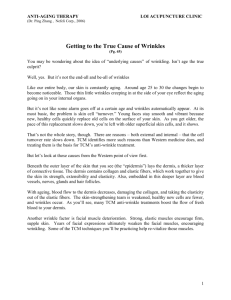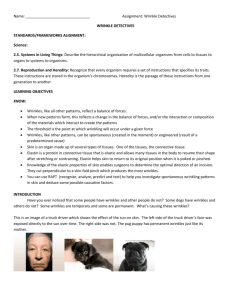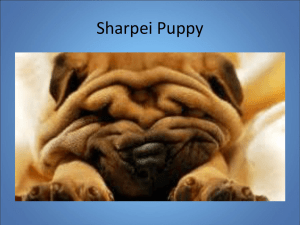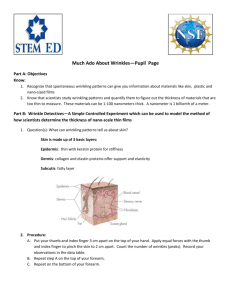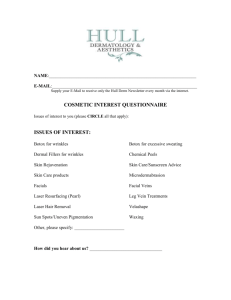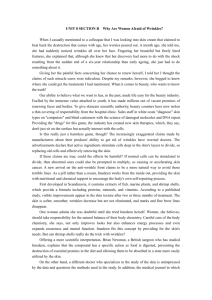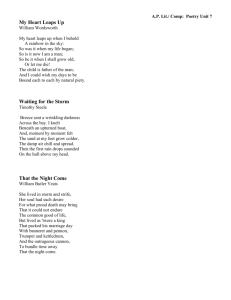Name: Assignment: Wrinkle Detectives WRINKLE DETECTIVES
advertisement
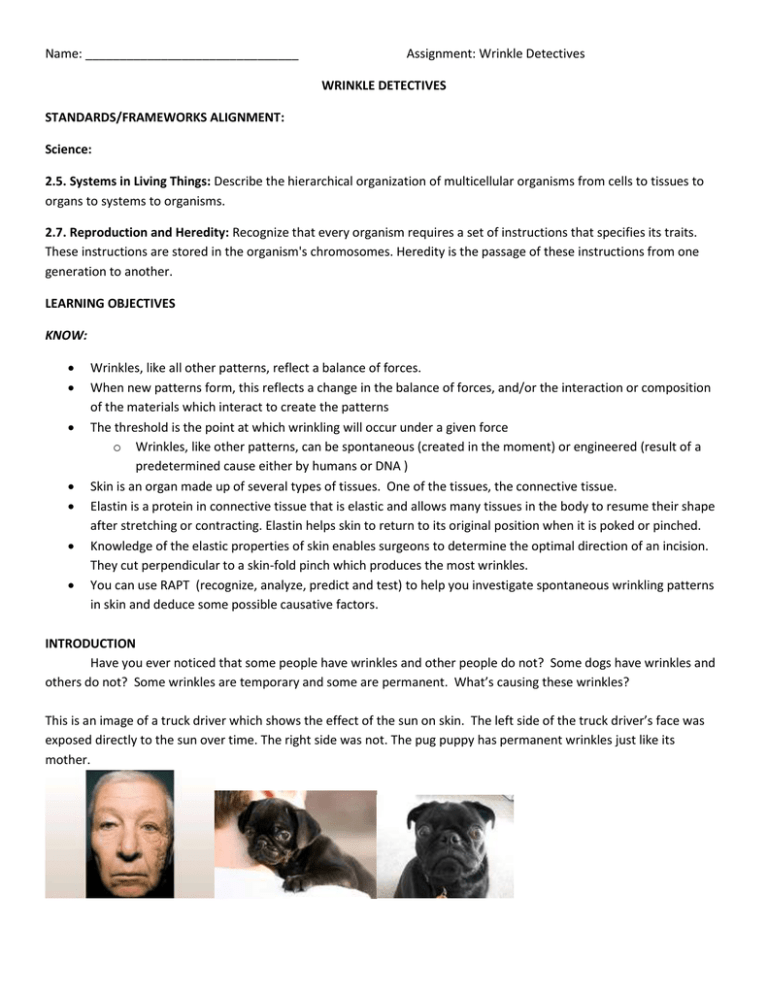
Name: _______________________________ Assignment: Wrinkle Detectives WRINKLE DETECTIVES STANDARDS/FRAMEWORKS ALIGNMENT: Science: 2.5. Systems in Living Things: Describe the hierarchical organization of multicellular organisms from cells to tissues to organs to systems to organisms. 2.7. Reproduction and Heredity: Recognize that every organism requires a set of instructions that specifies its traits. These instructions are stored in the organism's chromosomes. Heredity is the passage of these instructions from one generation to another. LEARNING OBJECTIVES KNOW: Wrinkles, like all other patterns, reflect a balance of forces. When new patterns form, this reflects a change in the balance of forces, and/or the interaction or composition of the materials which interact to create the patterns The threshold is the point at which wrinkling will occur under a given force o Wrinkles, like other patterns, can be spontaneous (created in the moment) or engineered (result of a predetermined cause either by humans or DNA ) Skin is an organ made up of several types of tissues. One of the tissues, the connective tissue. Elastin is a protein in connective tissue that is elastic and allows many tissues in the body to resume their shape after stretching or contracting. Elastin helps skin to return to its original position when it is poked or pinched. Knowledge of the elastic properties of skin enables surgeons to determine the optimal direction of an incision. They cut perpendicular to a skin-fold pinch which produces the most wrinkles. You can use RAPT (recognize, analyze, predict and test) to help you investigate spontaneous wrinkling patterns in skin and deduce some possible causative factors. INTRODUCTION Have you ever noticed that some people have wrinkles and other people do not? Some dogs have wrinkles and others do not? Some wrinkles are temporary and some are permanent. What’s causing these wrinkles? This is an image of a truck driver which shows the effect of the sun on skin. The left side of the truck driver’s face was exposed directly to the sun over time. The right side was not. The pug puppy has permanent wrinkles just like its mother. The photo shows temporarily wrinkled fingers after someone has taken a VERY LONG bath…. The boy has spontaneous wrinkles… Mick Jagger does not! BACKGROUND Human skin is made up of several layers. Each layer is made up of different materials with different properties. The epidermis is the outside layer that you see. The dermis is underneath and it contains nerves, hair, blood vessels, glands and special cells which help it all stick together (connective tissue). Underneath all that is a layer of fat which can vary in thickness. The connective tissue plays an important role in skin wrinkling. Elastin is a protein in connective tissue that is elastic and allows many tissues in the body to resume their shape after stretching or contracting. Elastin helps skin to return to its original position when it is poked or pinched. Elastin is also an important load-bearing tissue in the bodies of vertebrates and used in places where mechanical energy is required to be stored. In humans, elastin is encoded by the ELN gene. PROBLEM/PURPOSE What do spontaneous wrinkling patterns on your skin suggest about elastin in your skin? Can you use data from wrinkling patterns on test spots to predict wrinkling patterns on other areas? Can you predict spontaneous wrinkling patterns for older or younger people? Is there a different threshold response in different test spots? What adaptive advantage might there be for variable elastin production on different parts of the body? How do the results of your tests support the notion that form follows function? How do the results of this lab relate to inherited wrinkling patterns in organisms like pugs? How is this lab related to real-life decisions that surgeons need to make? HYPOTHESES 1. If you compare different parts of your skin, then the number of spontaneous wrinkles you create will be (circle): the same, different. 2. If you compare different parts of your skin, then the threshold response will be: (circle) the same, different. 3. If you produce skin wrinkles by pinching with the same force in two different directions, then the resultant wrinkling patterns will be (circle): the same, different. MATERIALS Ruler, person, 11 inch x 1 inch paper strip, scotch tape PROCEDURE Prelab Investigation 1. Put the paper strip (latex, or old overhead projector film) on the table top. Put your first two fingers of each hand on either side of the paper. Gently push your fingers toward each other. What happens? (Sketch or photo would be appropriate here). 2. Roll a piece of tape so that it is double-sided. Put the tape on the table. Put the center of the paper on the tape. Again, put your first two fingers of each hand on either side of the paper. Push your fingers toward each other. What happens? 3. This activity serves as a simple model for skin wrinkling. The paper represents the epidermis. The tape represents connective tissue. a. What does this model suggest about the relationship between wrinkling, the epidermis, and the underlying connective tissue? b. How could you improve this model to more accurately reflect the role of elastin in skin wrinkling? Lab Procedure 1 1. Bend your elbow at a 90 degree angle with your forearm pointing up. Put your thumb and index finger 4 cm apart, gently press down and move them together until they are 3 cm apart. The force of pinching should be constant. It should be longitudinal, creating lateral wrinkles. Count the number of wrinkles that are created. Specify where on the arm to do this. 2. 3. 4. 5. Repeat step 1 on the back of your forearm. You should control all variables except the testing spot. Repeat Step 1 on the back of your hand, the front of your lower leg and the back of your lower leg. Record your data in the table. Now, straighten your arm and repeat steps 1 and 2. What do you notice? If the applied force is a constant, what does the change in wrinkling suggest about the properties/interactions of the materials? 6. Finally, predict how many wrinkles/cm you will have on a new test area, like the palm of your hand or your cheek. Test your predictions. DATA Testing Spot Forearm (picture here) Front of upper arm (include picture) Back of upper arm (picture) Forehead (picture) Back of lower leg (picture) Back of hand (picture) Number of Wrinkles/2 cm Number of Wrinkles/cm Lab Procedure 2: Threshold 1. Repeat steps 1-6 above but look for a threshold response. A threshold response is seen as the very beginning of wrinkling. 2. Record the distance at which you notice wrinkling beginning to occur. DATA Testing Spot Forearm Front of upper arm Back of upper arm Forehead Back of lower leg Back of hand Distance between fingers when wrinkling begins to form 3. Is there a relationship between wrinkling patterns and threshold response? Lab Procedure 3: Different Wrinkling Pattern Investigation 1. Repeat the pinch test on different areas except pinch the skin perpendicular to how you did in Lab Procedure 1. 2. Write observations in the table below. DATA Testing Spot Forearm Front of upper Back of upper arm Forehead Back of lower leg Back of hand Observations 3. Surgeons make incisions based on the wrinkling patterns in skin. They make incisions perpendicular to a skinfold pinch which produces the most wrinkles. Based on this knowledge, if you were a surgeon, in what direction would you make an incision on the forehead? CONCLUSION Recall that wrinkling patterns are a result of balanced forces, and the interactions and properties of materials. In this investigation, the applied force was a constant. a. What patterns did you notice? b. What do you suppose is the cause of the different wrinkling patterns on different parts of your body? c. What do you suppose is the cause of different wrinkling patterns between old and young people? d. What might cause wrinkling as someone ages? e. What might be the cause of being born with wrinkles (like a pug)? Extension Investigate the wrinkling that occurs when your hands are in water. Investigate various treatments for permanent wrinkles and describe how they work, i.e., do they treat external forces or forces that come from a change in the material properties of the skin? Further Reading on Wrinkling in Biology http://www.nature.com/nrmicro/journal/v11/n3/full/nrmicro2972.html http://phys.org/news/2013-01-science-finger-wrinkles.html
